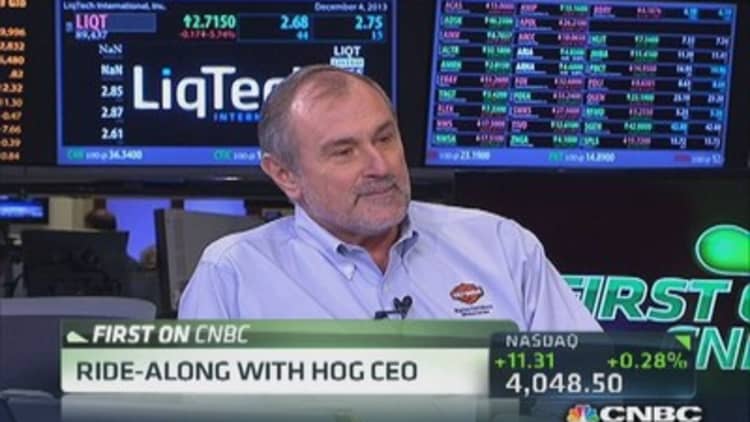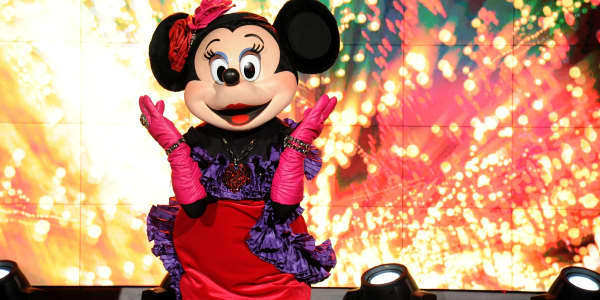More than 3,000 choppers rolled through the streets of Margate, South Africa, back in April, an event witnessed by over 110,000 biker enthusiasts who flocked to the country for what turned out to be the largest Africa Bike Week to date.
Riding in Africa is rising in tandem with the increase of middle-class consumers and their growing disposable income. It's an emerging market opportunity that has led Harley-Davidson—the ubiquitous symbol of biking—to start ramping up its African operations.
Over the decades, riding has maintained its bad boy image globally, fueled now with a high-end commercial twist that is turning Harleys into a "big boy toy"—just check out the decadent custom bikes featured in popular reality shows like "American Chopper." Harley as a status symbol is what appeals to an increasing number of Africans—a continent that has historically relied on motorcycles as a practical means of transportation.
The popularity of Harleys is part and parcel of the aspirations among Africans that explains why corporations—from Wal-mart, L'Oreal and Coca-Cola to spirit-maker Diageo and French retailer Carrefour—are flooding into the country. "When you speak to them, they want to buy Mercedes. ... They aspire to buy status cars," said John Simpson, the co-founder and director of the Unilever Institute of Strategic Marketing at the University of Cape Town.
(Read more: What exactly makes people middle class?)
Anybody that is going to come here is not going to make a quick buck. It's no small feat; it's a type of commitment that takes decades.Celine GruizingaCountry manager at Harley-Davidson Africa
Americana in Africa
The continent's middle class has tripled in size over the last 30 years, which today stands at 313 million. In less than 50 years Africa will be home to some 1.1 billion middle-class consumers, according to Deloitte.
There's a good reason why this past May the Hogs rode on South Africa, in particular: Two countries out of the 48 sub-Saharan countries—Nigeria and South Africa—account for more than half of all spending in the region, according to Euromonitor International data.
Even though a Harley may still be out of reach for most "middle-class" Africans—a group typically defined as those having between $2 and $20 to spend daily—a fully-loaded chopper marketed to the very wealthy is indirectly targeting the desires of a growing number of young Africans.
(Read more: Reached middle-class status? Start complaining about it)
Harley-Davidson has always exported its piece of consumer Americana to countries around the globe. In 1920 the company already had 2,000 dealers worldwide, operating in 67 countries. Today there are more dealerships overseas than in the U.S. for the first time in its 110-year history.
After World War II a lost generation of vets took to the open road, searching for the best years of their lives. The frustrated vets led to the rise of clubs, which helped perpetuate the "freedom from authority" lifestyle that began to penetrate the mainstream—like Brando's bad boy image in "The Wild One." Riding is one of the few original cultural phenomenons that America has given birth to—like jazz and westerns.

Hog wild
Harley-Davidson opened a subsidiary office in Capetown five years ago and currently has 11 authorized dealers in the sub-Saharan region—nine in South Africa and two on the Indian Ocean islands of Mauritius and Reunion. It plans to open another seven in South Africa next year.
From January 2008 to December 2012, H.O.G (Harley Owners Group) membership rose 70 percent in sub-Saharan Africa. The number of H.O.G chapters rose from nine in 2008 to 17 this year, with a total of 3,589 paid-up H.O.G members through June, according to Harley-Davidson data. Women riders account for 26 percent of sub-Saharan riders when last counted (2012).
"You have to take the full picture," said Celine Gruizinga, country manager at Harley-Davidson Africa. To get a pulse on disposable income, she said, corporations like Harley-Davidson look at how many golf clubs are being swung or how many Prada storefronts are beginning to pop up in particular markets.
(Read more: Why keeping up with the Joneses just got tougher)
Harley-Davidson took notice of the growing young and black South African demographics attending its Africa Bike Week year after year—a strong sign that demand is growing for motorcycles as a sport. Another sign that riding in Africa is transitioning past practical means of transport to pastime: The Hells Angels has charters in South Africa. U.S.-based Hells Angels spokesman Rick Ciarniello declined to comment on the club's presence in and expansion plans for Africa.
Harley-Davidson's entrance into the African market has been slowed more by its private dealership structure than by its limited consumer appeal. "When I first came in 2011, we worked hard to find investors; it was more difficult to find people to invest in the brand," Gruizinga said.
Nearly three years later things are starting to turn around. Gruizinga said that investors from various sub-Saharan countries are seriously considering getting into the game. Harley-Davidson Africa has recently seen interest from what Gruizinga referred to as "strong potential investors" wanting to invest in Angola and Kenya. "In Angola we have seen there is regular shopping-center investment; consumer spending continues to rise. Certainly, there has been wealth there for a few years now," she said. As the region continues to stabilize, long-term investments in additional east African countries would be considered by Harley.
Honda recently opened a motorcycle plant in Kenya to meet the country's growing demand. According to Kenya's National Bureau of Statistics, bike sales in Africa were up 86 percent by the end of April.
Emerging markets remain a slow-moving vehicle for Harley, though. In the third quarter, the company scored its biggest new-model sales increase in two decades, but EMEA region sales (Europe, the Middle East and Africa) accounted for less than 2 percent of the growth.
Sarah Boumphrey, head of countries and consumers at Euromonitor International, said lack of brand recognition and access to credit and various payment options are among the top challenges that the rising middle class has to overcome. Multinational corporations are well positioned to address these issues and speed up their own return on investment in emerging markets.
"Anybody that is going to come here is not going to make a quick buck," Gruizinga said. "It's no small feat; it's a type of commitment that takes decades."
—By Anthony Volastro, Segment Producer, CNBC. Follow him on Twitter @VolastroCNBC.




